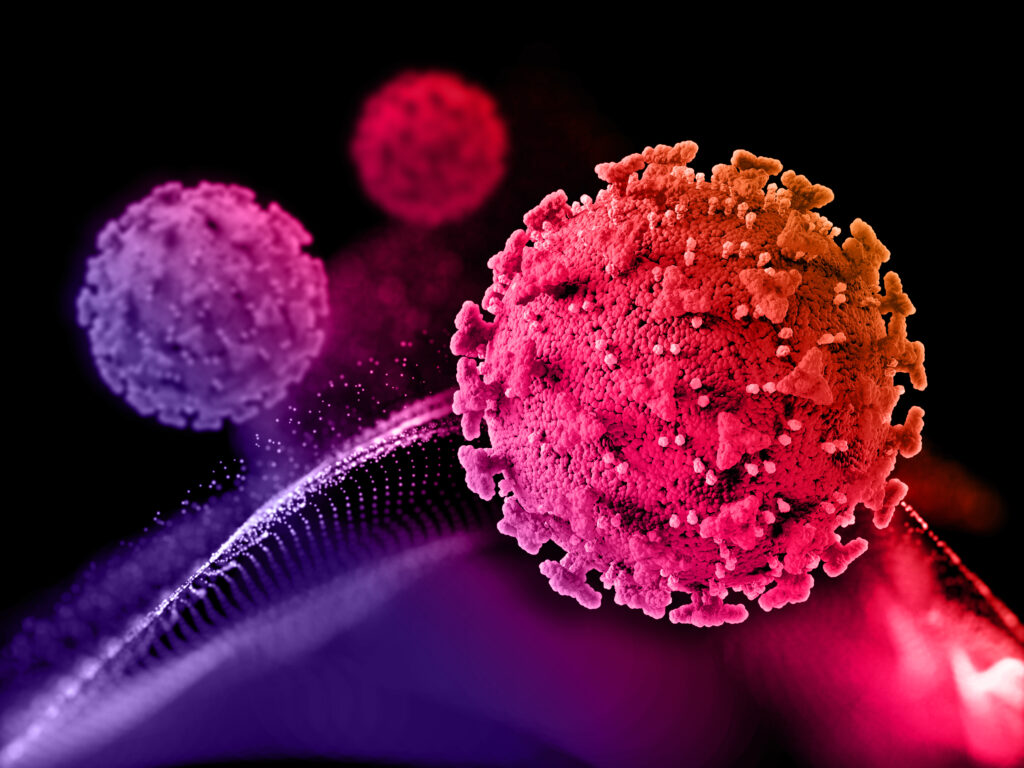cervical intraepithelial neoplasia.
HPV types 16 and 18 play a significant role in cancer development. HPV 18 accounts for approximately 7-20% of cervical cancer cases, while HPV 16 is responsible for 50-70% of cases. Other highly oncogenic types include 31, 33, and 45.

HPV is a widespread virus. It is estimated that as many as 80% of adult women who have sex have come into contact with the HPV virus or will come into contact with it in the future. Most of its varieties are harmless to health, but some cause visible symptoms (condylomas), and oncogenic types can contribute to the development of cancer.
Infections occur during sexual contact, as a result of skin contact, and not as in many other cases – as a result of contact with secretions, so it is important to remember that a condom reduces the risk of infection but does not eliminate it 100%. Penetration does not have to occur, also in terms of HPV infection, petting, which is popular among teenagers, is dangerous.
Condylomas or warts that appear in one of the spouses a few years after the wedding also cause concern. It does not necessarily mean infidelity. Some types of viruses develop for a more extended period or are asymptomatic in one spouse and cause warts in the other. The virus can be activated by, for example, a stressful situation or a temporary decrease in immunity. Therefore, instead of mutual blame and scenes of jealousy, it is worth going to the doctor together to explain the basis of the infection.
When it comes to HPV responsible for warts, the matter is much more complicated. It is easy to catch HPV. Infection can occur, for example, at a swimming pool, in a sauna, or on the beach (by using the same towel). Unfortunately, warts can also be contracted at a beauty salon during manicures and pedicures, which is why it is so important to maintain hygiene rules and disinfect tools, mainly cuticle nippers.
HPV (human papillomavirus) infection typically occurs through sexual contact with someone who carries the virus. Women aged 20 to 25 are at the highest risk of infection. The most typical manifestation of HPV infection is the development of warts in the genital area. For those infected with oncogenic strains of HPV, a notable clinical symptom is cervical intraepithelial neoplasia (CIN). Condoms do not provide 100% protection against HPV during sexual intercourse.
Another possible route of infection is from a mother to her newborn or fetus. This transmission usually occurs during childbirth or, in some cases, through transplacental infection during pregnancy. Most infants who their mothers infect can eliminate the virus spontaneously within their first 12 months of life.
The risk factors for HPV infection include:
One of the most dangerous diseases caused by the HPV virus is cervical cancer – one of the most common cancers in women. Does this virus always lead to cancer? Of course, not every HPV infection ends in the development of cancer, but every case of cervical cancer is caused by the papillomavirus.
HPV viruses have different oncogenic potential – some of them cause benign changes on the skin and mucous membranes (so-called warts), others can be the main cause of the development of cancer:
The development of pre-cancerous and cancerous changes in the cervix primarily affects women over the age of 35 who are exposed to chronic infections caused by oncogenic viruses, mainly types 16 and 18 HPV.
Cervical cancer is a typical malignant tumor of the female reproductive organs that forms in the cervix. The uterus is made of smooth muscle and consists of the body, which is inside the woman's pelvis and is the site of pregnancy, and the cervix, which is partially in the vagina.
The function of the cervix is mainly to maintain the developing pregnancy inside the uterus by tightly sealing the cervical canal. During labor, the cervical canal opens and widens significantly. Outside of pregnancy, the narrow cervical canal provides a path for sperm, protects against infections, and helps remove menstrual blood, and cervical contractions play a role in a woman's experience of orgasm.
The most typical location for cancer to develop is the so-called transition/border zone. It owes its name to the fact that it is a place of change between two types of epithelium: glandular – lining the uterine cavity and the cervical canal, and flat – covering the vaginal part of the cervix and the vagina. From the vaginal part, we can also distinguish the so-called shield. The location of this zone is variable and depends on age and the concentration of hormones in the body. In young girls and after menopause, it is located internally in the cervical canal. During hormonal activity, it is on the shield of the vaginal part of the cervix, in the area of its external opening.
The shield may be covered with glandular epithelium, and then we talk about the so-called ectopy (colloquially called erosion, epithelial defect, erythroplakia). This is a physiological process and does not require treatment, and the term erosion is incorrect and should not be used. In young women, there is a transition zone within the ectopy, where potentially cancerous changes will be located.
It is currently believed that the most significant risk factor for growing cervical cancer is HPV infection of the epithelial cells of the cervix. Much less frequently, the virus nests in the epithelium of the vagina or labia, leading to diseases of these areas. In the vast majority of cases, the woman's body eliminates the virus itself, but persistent infection occurs in a certain percentage of cases. It means that the virus permanently occupies the epithelial cells of the cervix, which can lead to their changes – so-called dysplasia, leading to disorders and functions and development, and sometimes to malignancy and cancer development. HPV infection cannot be cured, just as there is no cure for the influenza virus. The patient should be monitored and in the case of chronic infection, checks should be intensified, and in the case of dysplasia, appropriate treatment should be applied.
It follows that lifestyle has a huge impact on the risk of developing cervical cancer. Appropriate lifestyle modification, regular cytological and gynecological tests, and vaccination minimizes this risk.
The first symptoms of HPV often resemble symptoms of other ailments, which is why they can be confused with them. HPV-induced genital warts present similarly to hemorrhoids, while HPV in the throat can be confused with a common infection or inflammation of the mucous membrane.
The easiest way to recognize human papilloma is on the skin. These lesions typically present as discolored, whitish lumps or small nodules that are usually painless.
It also happens that the infection caused by the human papillomavirus is in other organs or parts of the body, and then its course looks different:
Every woman should regularly visit a gynecologist and have cytological tests performed at approximately three-year intervals. It is necessary to visit a doctor if any changes occur in the genital area (warts, condylomas) or symptoms appear, such as:
In the case of changes in the form of warts around the anus, nasopharyngeal cavity, or skin, a dermatologist should be consulted.
Many patients have questions about how to perform an HPV test. The first stage in the test is to collect the material for testing correctly. Do not schedule the examination during your menstrual period. The best time for the test is at least two days after the bleeding has stopped. Do not use douching or vaginal medications for two days before the test, and refrain from sexual intercourse for 24 hours before the test.
A smear is taken from the cervix using a sterile brush. The specialists inserted the brush into the opening of the cervical canal and rotated five times around its axis. In men, the sample is collected from the sulcus retrograde. The collected material is then placed in a liquid medium, allowing the cellular material to be washed into a container.
The HPV DNA test itself is not painful. This test utilizes the PCR (polymerase chain reaction) method, which amplifies DNA, enabling the detection of even small amounts of nucleic acid.

So far, no universal, effective method of treating the HPV virus of any type has been discovered. Therapy in the event of its diagnosis consists primarily of supporting the work of the immune system. There is no cure for the HPV virus that could eliminate it. Drug treatment supports the immune system so that the body can get rid of the virus and prevent the infection from developing.
It is usually used in local symptomatic treatment, eliminating or eliminating the changes that have occurred – warts or condylomas. In the case of skin changes, a visit to a dermatologist is necessary, while a gynecologist usually treats changes in the genital area in women.
In some cases, they are treated with hormonal therapy; in others – with local anti-inflammatory drugs (e.g., an ointment for changes caused by the HPV virus) or surgically. Local tissue destruction techniques can be used, e.g., cryocoagulation or vaporization.
When the human papillomavirus is present in the body, a doctor should be consulted to implement appropriate procedures or perform additional tests.
Venereal diseases are caused by various pathogens — viruses, fungi, bacteria, or parasites. Many of them are asymptomatic and, unfortunately, easy to miss. Then, the disease poses a threat not only to the infected person but also to all of their sexual partners. That is why it is so significant to carry out appropriate tests for venereal diseases based on various materials. They are most often performed on blood or from a swab from the anus, vagina, or from under the foreskin. Serological and bacteriological tests are mainly used in diagnostics. It is also possible to use home tests over the counter. However, they are less reliable compared to tests carried out in a laboratory.
The spread of venereal diseases can be prevented. There are several ways to do this:
The types of vaccines, along with their scope of action and the vaccination cycle, are as follows:
It is essential to follow the recommended vaccination schedules to ensure optimal protection against HPV.

Vaccines against human papillomavirus (HPV) are safe and generally well tolerated. To date, they have not been associated with any significant health problems in individuals who have been vaccinated. These vaccines are non-live, meaning they do not contain live viruses; instead, they include only some of the virus's antigens, proteins that cannot cause illness but are sufficient to trigger immunity against the virus. As a result, they are also safe for people with immune disorders.
Routine HPV vaccination is recommended for girls and boys aged 11–14 years. The optimal time for vaccination is 11–12 years of age. Children receive the vaccine in a two-dose regimen, with an interval of at least 6 months between doses. People over 15 years of age can also be vaccinated, they should receive the vaccine in a three-dose regimen, according to the characteristics of the medicinal product of the vaccine used. Bivalent vaccine in a 0, 1, 6-month regimen, quadrivalent and nine-valent vaccine in a 0–2–6-month regimen. All doses should be administered within 1 year. If the vaccine was not received during puberty, it is advisable to use it as early as possible, preferably before sexual initiation. A preparation that can be administered to people up to 45 years of age has recently been approved for use, but the decision to vaccinate is made individually.
The vaccine should not be administered in the event of general contraindications to vaccination that apply regardless of the vaccine administered, e.g., severe hypersensitivity to the active substances or any excipients contained in the vaccine (permanent contraindication). The vaccine is not administered to pregnant women, but there is no need to perform a pregnancy test before vaccination. People who have experienced symptoms of hypersensitivity after the administration of the HPV vaccine should not receive further doses.
The presence of a minor infection, such as a mild upper respiratory tract infection or a low-grade fever, is not a contraindication to vaccination, but in such a situation, vaccinations are usually not performed (they should be postponed) so as not to confuse the symptoms of the disease with possible adverse events after vaccination. Vaccination can be performed when the acute symptoms of the disease have subsided.
The diagnosis of HPV is not a definitive sentence; in many cases, the prognosis is quite good. The body often fights the virus and may eventually eliminate it. How long the HPV virus remains in the body depends on individual immunity. However, until it is eradicated, it is significant to exercise caution, maintain regular medical supervision (particularly by a gynecologist or urologist), and prevent the virus from spreading to others.
Table of Contents